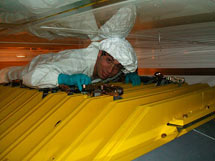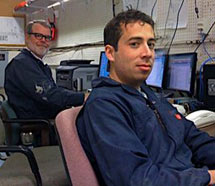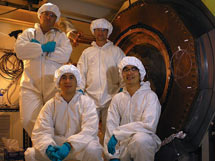
Handy Links
SLAC News Center
SLAC Today
- Subscribe
- Archives: Feb 2006-May 20, 2011
- Archives: May 23, 2011 and later
- Submit Feedback or Story Ideas
- About SLAC Today
SLAC News
Lab News
- Interactions
- Lightsources.org
- ILC NewsLine
- Int'l Science Grid This Week
- Fermilab Today
- Berkeley Lab News
- @brookhaven TODAY
- DOE Pulse
- CERN Courier
- DESY inForm
- US / LHC
SLAC Links
- Emergency
- Safety
- Policy Repository
- Site Entry Form

- Site Maps
- M & O Review
- Computing Status & Calendar
- SLAC Colloquium
- SLACspeak
- SLACspace
- SLAC Logo
- Café Menu
- Flea Market
- Web E-mail
- Marguerite Shuttle
- Discount Commuter Passes
-
Award Reporting Form
- SPIRES
- SciDoc
- Activity Groups
- Library
Stanford
Around the Bay
People: Jesse Wodin Takes it Underground
SLAC physicist Jesse Wodin has something of a long commute. To get to work, Wodin has to fly to El Paso, Texas; drive 160 miles to Carlsbad, New Mexico; drive another 26 miles into the desert and then take a five-minute elevator underground.
All of this is to get to the Waste Isolation Pilot Plant in New Mexico, a Department of Energy storage site carved from gargantuan salt beds 2,150 feet beneath the New Mexico desert. The site, which is used primarily to store nuclear waste, is home to the Enriched Xenon Observatory, an international collaboration to detect rare subatomic events in a giant tank of super-chilled liquid xenon.
Why so far out of the way? Because bombardment from natural radiation could disturb the xenon in the EXO detectors and overshadow the events researchers are hoping to observe, the experiment has to be carried out in a well-sheltered environment. The thick-walled salt caverns at WIPP will act as a natural shield, keeping background noise low and making sure that the sought-after signal isn't drowned out by incidental events. EXO researchers will start collecting data at the end of the year.
Wodin is a manager on the project, working to make sure that day-to-day operations go smoothly and that everything stays on schedule. His daily tasks range from working with technicians and testing the project's many subsystems to figuring out how to prevent heavy cargo containers from sinking into the soft floor of the salt caverns. While some scientists live full time at the site, Wodin works in shifts, making the trip to WIPP every three weeks and staying at the site for up to three weeks at a time.
As one might expect, adapting complex and sensitive physics experiments to subterranean salt caverns presents some difficulties. For example, there are only two elevators, meaning that larger objects—like the 70- by 12-foot clean room used at the site—had to be built, broken down, then rebuilt on the cavern floor. The air provides another problem. As anyone who has lived on the coast knows, salty air doesn't exactly agree with metal surfaces, let alone sensitive pieces of experimental equipment. For Wodin, though, these challenges are all part of what makes the project interesting.
"It's fascinating trying to do science in this completely alien environment." Wodin said. "The juxtaposition of all the sorts of dirty, heavy equipment and industrial kind of stuff that's going on there, contrasted with our extremely clean science—it's just a funny thing."
Wodin first started working on the EXO experiment nine years ago as a graduate student at Stanford. He came across the project by chance, but found he enjoyed the people he was working with. After finishing his doctorate, he stuck around.
Aside from the people and the place, Wodin is drawn to the project because of its potential to explain the unknown. According to Wodin, if researchers observe the event they're looking for, called neutrinoless double beta decay, it could provide answers to some of the most fundamental questions in physics, including why there seems to be more matter than antimatter in the universe.
"Neutrino physics right now is kind of in an explosive stage," Wodin said. "It points to physics beyond the standard model, [the theory explaining the interactions of fundamental particles]."
At the end of each three-week stint at WIPP, Wodin travels back to SLAC, where he helps tend to some of the more terrestrial aspects of the project. He always looks forward to going back out into the desert, though.
"It's really fun," Wodin said. "Even after two years it has not gotten old."
—Nicholas Bock
SLAC Today, June 17, 2009


